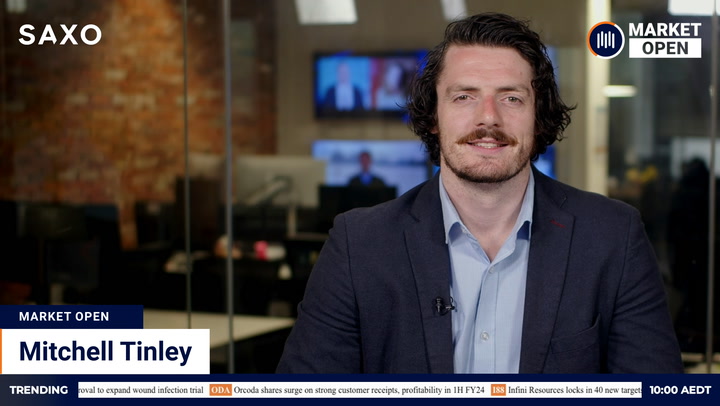Investors were bracing for a bruising start to the week following heavy selling on Wall Street after the Federal Reserve warned of “pain for households and businesses” in the war on inflation.
Futures trading suggests the S&P/ASX 200 will open 104 points or 1.48 per cent lower this morning. Brutal though that sounds, it is a scratch compared to damage on Wall Street on Friday.
All three major US indices tumbled at least 3 per cent. The S&P 500 had its worst session since June. The Dow lost more than 1,000 points. The Nasdaq Composite shed almost 4 per cent.
The domestic full-year reporting season continues today. Fortescue Metals and Northern Star are among companies to release earnings into today’s challenging market.
Wall Street
US stocks tanked after Fed Chair Jerome Powell blew away any lingering hopes of a “pivot” in the war on inflation. Powell told a gathering of central bankers the US’s commitment to crushing inflation by raising rates was “unconditional”, even it meant pain for the economy – and by extension, stock prices.
The S&P 500 dived 141 points or 3.37 per cent. Just five stocks resisted the selling. The Dow Jones Industrial Average shed 1,008 points or 3.03 per cent. The Nasdaq Composite gave up 498 points or 3.94 per cent.
“Reducing inflation is likely to require a sustained period of below-trend growth,” Powell told the Jackson Hole symposium. “While higher interest rates, slower growth, and softer labour market conditions will bring down inflation, they will also bring some pain to households and businesses.”
The Fed chief did not indicate whether the bank would raise its benchmark rate by 50 or 75 basis points next month, but he warned rates would likely remain elevated for some time.
“Restoring price stability will likely require maintaining a restrictive policy stance for some time. The historical record cautions strongly against prematurely loosening policy,” he said.
Friday’s sell-off drew a curtain on an extended period of low volatility and stock market recovery during the northern summer. The S&P 500 bounced almost 19 per cent from its June low to this month’s high.
“It feels like investors have literally been at the beach all summer and forgetting about the problems that exist economically,” Ryan Belanger, founder and managing principal at Claro Advisors, told MarketWatch. “Chair Powell’s remarks just kind of refocused the lens here.”
Wall Street’s “fear gauge”, the VIX or volatility index, jumped 17 per cent. The treasury yield curve remained inverted, a possible sign a recession is looming.
Powell’s blunt remarks came as a measure of inflation declined for the first time in 20 months. The personal-consumption price index (PCE) eased 0.1 per cent last month as pump prices declined. The decline helped pull annual headline inflation down to 6.3 per cent from 6.8 per cent.
Core PCE edged up 0.1 per cent for the month, half the increase predicted by economists. The year-over-year rate declined to 4.6 per cent from 4.8 per cent.
Rate-sensitive growth stocks led the retreat as treasury yields initially spiked, then relaxed. The Russell 1000 Growth Index slumped 3.83 per cent, compared to a 2.86 per cent slide for the Value Index.
The declines sealed a losing week for the major indices. The S&P 500 shed around 4 per cent, the Dow 4.2 per cent and the Nasdaq 4.4 per cent.
Australian outlook
A challenging session coming up as the S&P/ASX 200 plays catch-up with falls on Wall Street. The Australian benchmark fell less than 0.1 per cent last week, versus declines of at least 4 per cent in the US. That gap is likely to narrow today.
While the outlook for inflation and therefore rates appears less severe here than in the US, Australian lenders rely on international markets for some of their funding, meaning there is no immunity here to higher rates in the US. Banks and other lenders will pass on the increased cost of borrowing to Australians.
Havens were notably absent on Friday in the US. All 11 US sectors declined. The NYSE Arca Gold Bugs Index skidded 4.84 per cent. BHP and Rio Tinto outperformed in a sinking market, but still finished lower in US trade (more below).
Energy was the least-worst of the US sectors with a fall of 1.07 per cent. Utilities, consumer staples and real estate were next-best with losses of 1.5-2.5 per cent.
The three sectors dominated by Big Tech were hit hardest with declines of 3.9-4.3 per cent. Basic materials shed 3.14 per cent. Financials dropped 3.03 per cent.
Back home, reporting season is in the home stretch as the end of the month nears. Among today’s highlights are Fortescue Metals, Northern Star, Mineral Resources, McMillan Shakespeare, InvoCare, Waypoint REIT and Michael Hill.
Tomorrow’s line-up includes Woodside Energy, Healius, IGO, Link Administration and A2 Milk. The season winds down with St Barbara and Atlas Arteria on Wednesday.
Firms holding AGMs this week include Webjet on Wednesday and Collins Foods on Friday.
September is a historically weak month for stocks, in large part because of the impact of the outflow of dividend payments on prices. Dozens of companies will trade ex-dividend this week.
Among the larger names are Ansell, Worley and Challenger today, Beach Energy, Domino’s Pizza and Evolution Mining tomorrow, Tabcorp, Woolworths and Treasury Wine Estates on Wednesday, BHP, AGL and Whitehaven on Thursday, and Coles, Ampol and Altium on Friday.
On the domestic economic calendar this week: retail sales (today); building approvals, weekly consumer confidence (Tuesday); construction work, private-sector credit (Wednesday); and private capital expenditure (Thursday).
Friday night’s jobs report is a likely highlight in the US. With all eyes now on the economy, Tuesday night’s consumer confidence and jobs openings data could also have an impact, along with non-farm employment change (Wednesday) and manufacturing (Thursday).
IPOs: another desperately thin week ahead. The only potential starter this week at time of writing is explorer Aeramentum Resources on Thursday.
The dollar steadied this morning, rising 0.47 per cent to 68.86 US cents.
Commodities
Oil rounded off a positive week with another up-leg after Saudi Arabia hinted US$90 a barrel was a red line where the OPEC+ oil cartel would reduce production to prevent further price falls.
“Admittedly, sources close to OPEC stressed shortly afterwards that a production cut would probably only happen if Iran were to return to the oil market as a result of a new nuclear agreement. Nonetheless, the impression remains that Saudi Arabia is not willing to tolerate any price slide below $90,” Commerzbank analysts wrote.
Brent crude settled US$1.65 or 1.7 per cent higher at US$100.99 a barrel. For the week, the international benchmark gained 4.4 per cent.
Iron ore wrapped up its best week in a month with another rise amid reports of Chinese steel mills increasing purchases. Extreme heat in parts of the country had previously hampered the construction industry, dampening demand for steel.
“Market is better than before. Now steel mills keep very low inventory. When the temperature drops, demand from end-users will come again… may be in 1-2 months. There will be more demand for raw materials,” a China-based trader said, according to Reuters.
The most-traded January ore contract on the Dalian Commodity Exchange climbed 3 per cent to 735 yuan (US$107.10). For the week, the contract gained 6.4 per cent.
The spot price for ore landed in China firmed 42 US cents or 0.4 per cent to US$105.38 a tonne. For the week, the spot price improved 1.1 per cent.
BHP and Rio Tinto rose in UK trade before falling when the market mood soured in the US. BHP‘s US-traded depositary receipts sank 1.75 per cent after its UK stock gained 0.28 per cent. Rio Tinto rose 0.59 per cent in the UK and fell 0.76 per cent in the US.
Gold wilted under the threat of higher US rates for longer. Gold for December delivery settled US$21.60 or 1.2 per cent lower at US$1,749.80 an ounce.
“A restrictive monetary policy is not friendly for gold,” Jeff Wright, chief investment officer at Wolfpack Capital, told MarketWatch.
Copper neared a two-month high as soaring energy prices raised questions about the outlook for supply. Energy-intensive aluminium and zinc also rallied. Smelters in Europe have been suspending production in the face of soaring costs.
Benchmark copper on the London Metal Exchange climbed 0.3 per cent to US$8,188.25 a tonne. Aluminium gained 2.4 per cent, zinc 0.6 per cent, lead 0.6 per cent and tin 1.9 per cent. Nickel eased 0.2 per cent.





